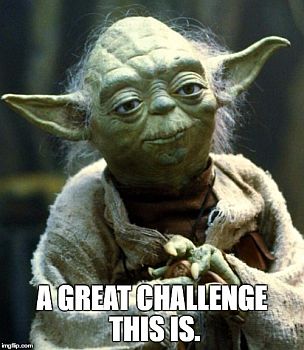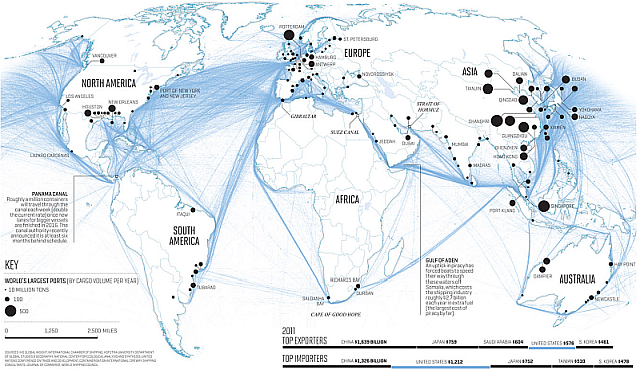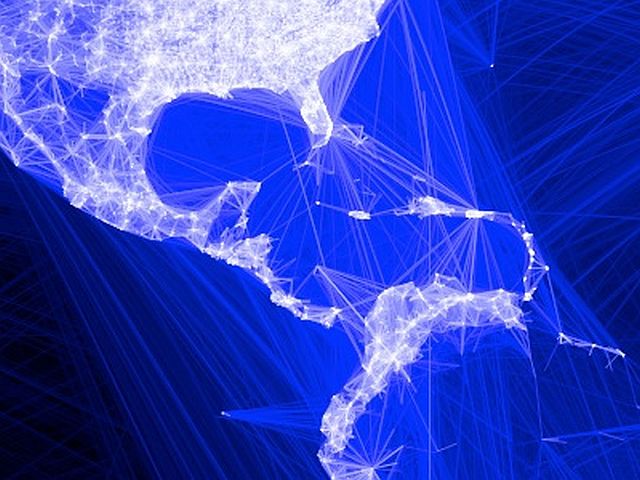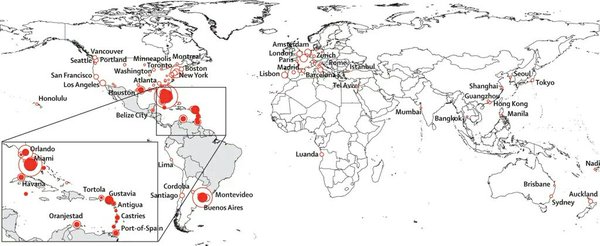CGW4U
World Issues: A Geographic Analysis
Unit 2: Asia
Activity 4: When did globalization start? Should it end?
The 1 to 2 billion poorest [people] in the world, who don't have food for the day, suffer from the worst disease: globalization deficiency. The way globalization is occurring could be much better, but the worst thing is not being part of it. For those people, we need to support good civil societies and governments.
Globalization is a term that is used with great frequency. The thing is, few people can confidently define it! Additionally, much controversy swirls around this concept. Developing a working definition is an important starting point for this activity.
 Consider
Consider
Complete the following quiz. From the information you learn, write your best definition of the term Globalization.
 Question
Question
Now compare your definition to the one to be used for the purposes of this course.
AnswerFor our purposes, globalization can be defined as the process by which different parts of the world interact economically, politically, and socially. It includes interconnections facilitated by technology and communications. The influence of globalization goes well beyond trade to influence people, immigration, employment, ideas and knowledge.
Part 1: When Did Globalization Begin?
Based on the definition generated above where would you conclude globalization began?
 Issues Café: When did globalization begin?
Issues Café: When did globalization begin?
Use the information In the timeline to answer the question: When did globalization begin? This is not necessarily an easy question to answer.
 H.O.T. Topic - The Extent of Globalization
H.O.T. Topic - The Extent of Globalization
Scenario
Consider the viewpoints put forward by both Friedman and Ghemawat. Is the extent of globalization real or is it overstated? Which side of the argument do you agree with? Create a meme that conveys your personal opinion regarding the extent of globalization. Your meme should make it obvious as to which viewpoint you side with (Friedman or Ghemawat).
You can use a free meme generator.
Social Action?
Can you identify a media outlet that might be interested in publishing a sampling of your class memes?

While Friedman can be criticized for his lack of data, Ghemawat can be criticized for selective use of data to build his thesis.
What we can agree on, is that globalization is happening and it does impact our daily lives. How do we want to move into the future?
Examine all five of the following maps. Look for any patterns in the information each of the maps provide.
From the five maps in the above carousel, we can see that we are connected, that there are interrelationships shown.
As a Geographer, it is important to be able to determine and describe patterns. Look again at the maps, this time looking not only at the image, but also what the data is telling you in the maps. Even within this small set of five images, it is possible to look for patterns and draw conclusions by using the information contained on two different maps.
Finding the pattern is the first challenge, but describing the pattern is the second challenge. Try to describe the pattern you see in any one (or any combination) of these maps in a way that a person who didn't have the maps in front of them would understand it. Also explain, to the best of your ability, the forces that would have caused this pattern.
The map below was produced by the Swiss company KOF who produces the KOF Index of Globalization. This index measures global social, political and economic interactions for 207 countries and territories.
Sometimes looking for patterns isn't enough, rather we have to look through the patterns and search for anomalies - something that doesn't fit into the pattern as you might expect.
What can this map tell you about Canada’s level of globalization? First describe the patterns that you see in the map and then identify the anomalies that you are able to identify. Provide the reasons that you think have caused the pattern or anomalies you found.
Part 2: Forces of Globalization (How has it happened?)
We know we are "globalizing" but why? What forces have caused this trend? Click on each of the four globes below in order to access more information on the topic of The Forces of Globalization.
Part 3: Impacts of Globalization
Clearly, globalization is a very complex issue. Step back for a moment to see how you view this issue. Do you believe that it mostly impacts people? ...Or is it about economics? ...Or the environment or is it predominantly a political issue? For each of the following statements about the impacts of globalization, indicate where you think it aligns best by dragging the statement to: Social, Political, Economic or Environmental. You will notice that some of the statements support globalization while others are in opposition to it.
 Globalization
Globalization
Looking at the results of the sorting task above, did you see the effects of globalization as predominantly social, political, economic or environmental? ...Or did you see it as an equal amount of each? Did the exercise change your perspective? How would your conclusion alter the way we encourage or discourage globalization?
Share your decision with your classmates. Remember that there is no incorrect answer, as it's a matter of perspective and justification.
Free Trade Agreements
Free Trade Agreements are an important cause and consequence of globalization. These agreements reduce or remove tariffs and import quotas as well as identify preferences on most goods and services traded between participating countries.
Since WWII, many nations have engaged in multilateral (3 or more countries) trade agreements. These agreements mean that member countries do not function completely independently. Their trade and economy become interdependent with those of the other member countries.
Further, they are negotiated at the national level so many individual businesses may feel elated or betrayed by the final language of the agreement.
The North American Free Trade Agreement (NAFTA) for example, is a multilateral agreement between Canada, the United States and Mexico. This controversial agreement was designed to facilitate trade by removing many tariffs between member nations, creating a large free trade zone. NAFTA includes motor vehicles and automotive parts, computers, textiles, and agricultural products.
Other trade agreements include but are not limited to:
- Central American Free Trade Agreement (CAFTA) (7 members);
- European Union has many free trade agreements;
- Association of Southeast Asian Nation (ASEAN)(10 members).
Negotiations are underway for the following free-trade agreements:
- The Trans-Pacific Partnership (TPP) or Trans Pacific Partnership Agreement (TPPA) is a trade agreement among twelve Pacific Rim countries. Early in 2016 the proposal was finalized, and is now awaiting ratification from member nations. After seven years of negotiations, many are skeptical that all members will ultimately sign on.
- At the 2015 African Union Summit in South Africa, negotiations were launched to create a Continental Free Trade Area (CFTA). The goal is to have all 54 African Union states ratify by 2017.
 My Position on Globalization
My Position on Globalization
Part A
Answer one of the following questions:
- Would you encourage or discourage further globalization? Explain why.
- Should globalization end? Explain why.
- Would you conclude, from a geographic perspective, that globalization is or is not in Canada’s best interest? Explain why.
Use this Point, Proof, Explanation template provided as a guide to structure your response.
Your answer should be approximately 500 words and include examples (i.e., proof) to illustrate your thinking. Your work should include your definition of globalization, your belief on which geographic perspective is predominantly impacted by Globalization, and should use your analysis of the patterns represented in the 5 free trade agreements as supporting evidence for your opinion.
Part B
In Unit 1, you considered topics for the position paper you will write later in this course. To support you, throughout the course, there will be opportunities to practice the components of the inquiry process.
Below are:
- Two articles relating to globalization;
- An explanation of how to write an entry on an annotated bibliography;
- An exemplar of an annotation and;
- A checklist for an annotated bibliography.
1. Two Articles
Skim both articles and select one to use to practice writing an annotation. Keep “CRAAP" in mind as one of the goals of an annotation is to assess the appropriate and usefulness of your research.
2. How to Write an Annotated Bibliography
3. An Exemplar Annotation
Jill London is the Dean of Geography at Laurier University and author of several books and articles on spatial acuity. In this article she explains how our increased reliance on geo-technologies, specifically mapping programs on smartphones, contributes to the global decline of spatial acuity. She uses specific examples from different locations around the globe to illustrate her argument. London uses logical arguments and recent statistics from peer-reviewed articles to support her position. This article is clearly organized, and uses current data. The article clearly illustrates London's points, but does not explore their implications, leaving the reader with many unanswered questions. This article will help me develop my arguments but will not contribute to the development of a counter-argument.
Notice that the annotation does NOT merely review the content of the source material. It:
- summarizes the content (2-3 sentences);
- analyses the value of source material (4-5 sentences);
- identifies how this particular resource will be useful to your paper (1-2 sentences).
4. Checklist
The following checklist will not be evaluated, but should be used as a guide to ensure you have all the components necessary to complete this task.
| Criteria | Yes | No |
|---|---|---|
| Content: I have included appropriate...
|
||
| An assessment of the value of the source (complete 4-5 of the following): I am able to state the…
|
||
| Writing Style: My writing has suitable...
|
||
| Overall: My annotated bibliography…
|




